This was published 4 years ago
Turf, talent, and a bear: Behind the scenes as the Gabba prepares to host the AFL grand final
By Tony Moore
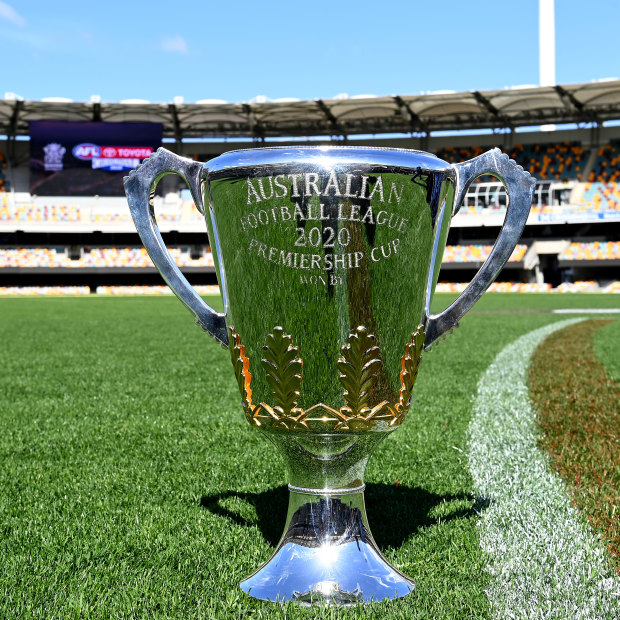
The 2020 AFL Premiership Cup at the Gabba.Credit: Bradley Kanaris/Getty Images.
In a coffee shop across the road from the Gabba, a towering, snarling bear wearing a Brisbane Lions guernsey is there for all to see.
The Gabba's rich green turf is now mowed into the AFL-accredited grid pattern, and speculation is rife that the Queensland Symphony Orchestra will perform the national anthem live on grand final day, October 24.
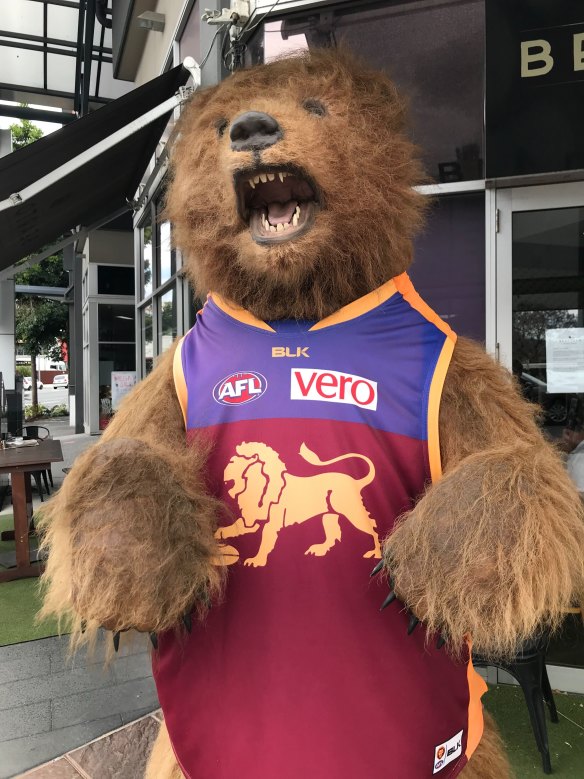
The Brisbane Lions are roaring in 2020. Credit: Tony Moore
Mike Brady will appear on the big screen singing Up There Cazaly, and there is plenty of buzz that Brisbane indie-pop champs Sheppard will belt out their monster hit Geronimo.
Entertainment plans for the AFL grand final will not be confirmed until grand final week. But that hasn't stopped speculation that Queenslanders Busby Marou and Eurovision entrant Dami Im will perform at the Gabba. The talk around town is that Amy Shark has said no.
At the 2020 grand final launch this week, AFL chief executive Gillon McLachlan said the entertainment would be all-Australian.
“It will be all Australian artists this year, and then we also involve the community – children, adults, community performers and volunteers who get the chance to be watched by three or four million people,” Mr McLachlan said.
“But we are here in Brisbane. It is the first time the AFL has played a grand final outside Melbourne, so I think there will be the right level of focus that we are here in Queensland.
“Football is growing at double digits up here – ratings are up 40 per cent.”
Mr McLachlan paused when asked which Queenslanders get the nod to perform after rock group Powderfinger declined.
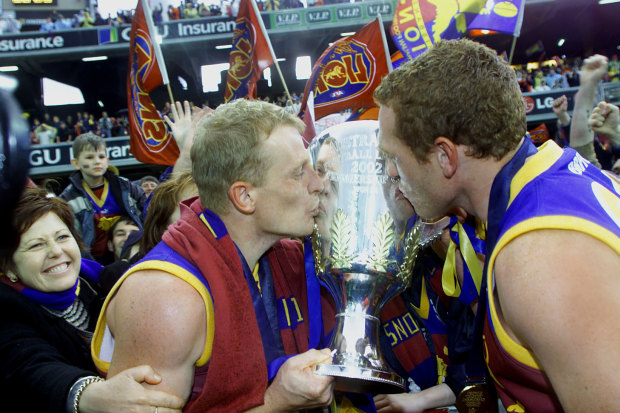
Michael Voss and Justin Leppitsch celebrate winning the 2002 AFL premiership.Credit: Joe Armao
“I’ve seen the emerging list and it’s a great list of Australian artists. Anything I say after that, I will just get into trouble," he said.
There could be a tribute to the Brisbane Lions' “three-peat” 2001-03 premiership-winning teams, headed by All-Australian skipper Michael Voss, he said.
“I think it’s a very good idea. I think it was one of the iconic teams and eras of the modern AFL,” he said.
“So I don’t know if anything is planned, but it’s a great idea.”
One member of that Lions team, Brownlow Medal-winning midfielder Simon Black, says a packed Gabba creates an astonishing atmosphere.
“The Gabba, with its cloth ceiling, the noise seems to reverberate around that,” he says.
“I always felt that 30,000 to 35,000 at the Gabba always seemed like a lot more at the MCG. I’m talking right up there.
“The acoustics at the Gabba are simply quite amazing.”
One thing is sure. A large stage will be built on the famous grass of the Gabba and it will be rolled away quickly to let the main event begin, stadium general manager Mark Zundans says.
“All I can say is that it will be a little bit different and it will be uniquely Queensland, albeit I am not at liberty to say anything about that."
The turf grid pattern mown into the field is chosen by the AFL and is different from the pattern for the cricket at the ground.
“You can’t leave a pattern cut in too long because then it won’t align when the cricket season begins because the wicket block looks off-kilter,” Mr Zundans says.
As we watch, a member of the ground staff shifts a string line down one section of the Gabba to give him a mowing line.
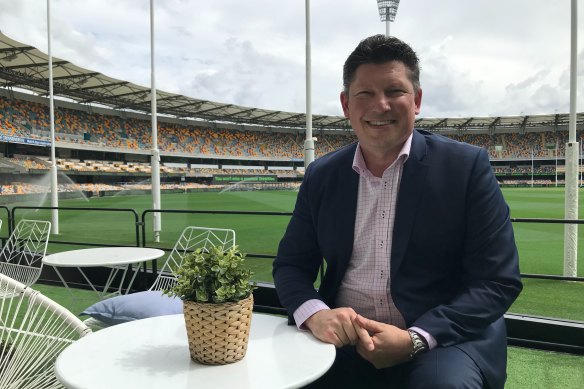
Gabba general manager Mark Zundans talks through what it takes to host an AFL grand final at the Gabba for the first time.Credit: Tony Moore
“By putting the mower down in one direction, it pushes the blade of grass one way,” Mr Zundans says.
“Then they loop back and come back the other way, so the light ones are the blades of grass that face away from you and the dark colours are the blades of grass leaning towards you and you get the grids – the square – by doing the same thing in the opposite direction.”
The AFL also uses a “Clegg test", which sets the soil hardness of the playing surface for the clash between players.
“There are also guidelines for the length of the turf itself,” Mr Zundans says.
“Cricket and the AFL differ. AFL has slightly longer grass primarily for its absorbing factors from the impact, whereas cricket has shorter turf primarily so the ball moves across the turf a bit better.”
The Gabba was humming with extra staff doing a deep clean before Friday’s Brisbane Lions v Richmond qualifying final.
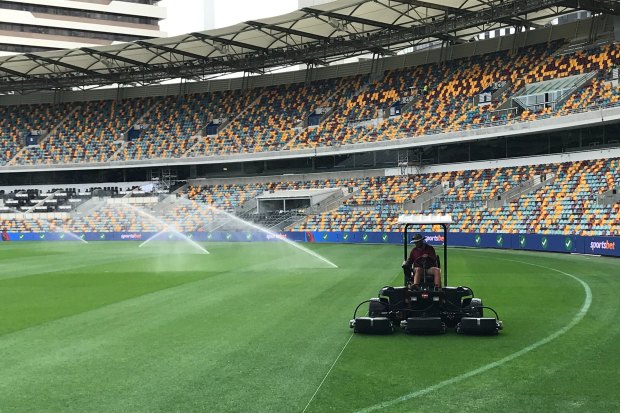
Cutting the AFL-specific grid into the Gabba turf.Credit: Tony Moore
An extra 14 people were working, up from a regular team of 15 cleaners, disinfecting and cleaning seats and rooms.
“We are doing a lot of deep cleaning that would normally be done between seasons, but we just want to make sure that we sparkle that little bit more,” Mr Zundans says.
The Gabba has new bars, food venues and entrances courtesy of a $35 million upgrade.
Twenty-five thousand tickets were on sale for the Lions-Tigers Friday clash and there could be close to 35,000 people in the Gabba when the grand final day rolls on.
It’s about 75 per cent of the Gabba's 42,000 capacity. There were 37,478 at the ground when Richmond stopped the Lions’ 2019 finals campaign.
Crowd numbers are a moving feast. Queensland Chief Medical Officer Jeannette Young will have the final say.
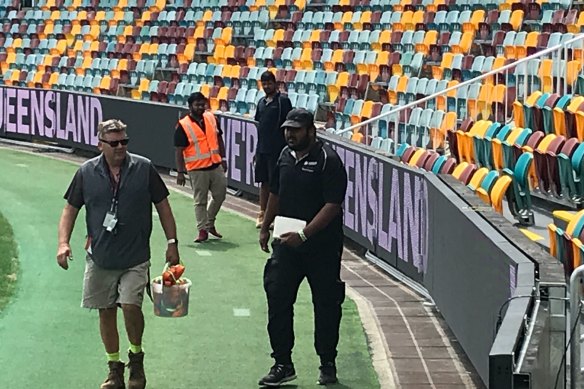
Ground staff at the Gabba check a new video cabling system allowing extra fence signage flexibility for advertisers.Credit: Tony Moore
As the 2020 season progressed, the distance between punters at football stadiums has reduced as COVID-19 restrictions lifted.
It started with a row and two seats between people, then a row between people, then a chequerboard pattern where no one sat in front or behind.
For the 2020 finals, people will sit in “pods” in five zones around the Gabba.
“Groups of maybe 300 to 400 people seated shoulder to shoulder, front to back, but then there will be a separation between them as well, so it is not over-congesting areas,” Mr Zundans says.
Each of the five sectors, on both the bottom and top level, can seat about 3000 people. The 10 sectors, when filled, can hold about 30,000.
Each sector has its own food, drink and bathroom facilities to restrict movement around the Gabba.
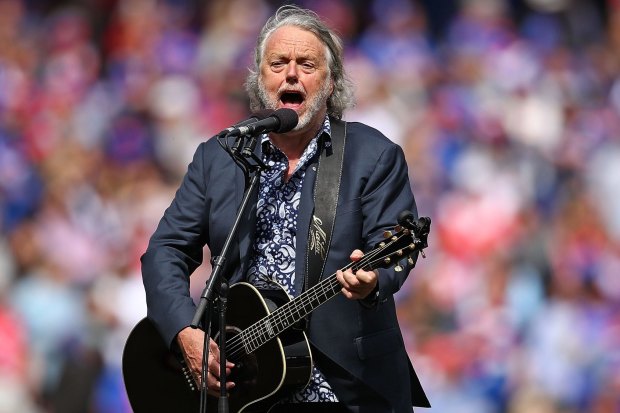
Mike Brady performs One Day in October during the 2016 AFL grand final.Credit: Scott Barbour
Stadiums Queensland is recommending people bring masks and wear them coming in and leaving the Gabba.
”At the times when there is going to be heavier congestion,” Mr Zundans says.
“It is not a requirement, it is just an additional precaution on that front so at the end of the game, when everyone is leaving, that is probably the time to exercise some caution.”